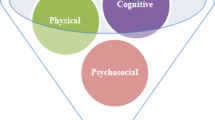Abstract
Cybersickness is a known issue in virtual reality affecting a notable percentage of the populations. However, predicting the level and incidence of cybersickness in new systems is difficult. Past publications were analyzed for their factors and resulting cybersickness scores. These factors were then used to develop three predictive models using demographics, software, and hardware factors. Using demographic information alone explained 44.2% of the adjusted variance in a linear model. Using hardware and software factors alone explained 55.3% of the adjusted variance in a linear model. Using demographics, software, and hardware factors did not use a linear model, but rather had an average residual error of 1.03. This residual error is an estimate of how far the predicted cybersickness score is from the actual score.




Similar content being viewed by others
References
Arns LL, Cerne MM (2005) The relationship between age and incidence of cybersickness among immersive environment users. Proc IEEE Virtual Real 2005:267–268
Bos JE, de Vries SC, van Emmerik ML, Groen EL (2010) The effect of internal and external fields of view on visually induced motion sickness. Appl Ergonom 41(4):516–521
Chen YC, Dong X, Hagstrom J, Stoffregen TA (2011) Control of a virtual ambulation influences body movement and motion sickness. In: BIO web of conferences the international conference SKILLS 1
Dizio P, Lackner JR (1997) Circumventing side effects of immersive virtual environments. In: International conference on human-computer interaction
Dong X, Stoffregen TA (2010) Postural activity and motion sickness among drivers and passengers in a console video game. Proc Hum Factors Ergonom Soc Annu Meet 54(18):1340–1344
Dong X, Yoshida K, Stoffregen TA (2011) Control of a virtual vehicle influences postural activity and motion sickness. J Exp Psychol Appl 17(2):128–138
Draper MH, Viirre ES, Furness TA, Gawron VJ (2001) Effects of image scale and system time delay on simulator sickness within head-coupled virtual environments. Hum Factors J Hum Factors Ergonom Soc 43(1):129–146
Golding JF (1998) Motion sickness susceptibility questionnaire revised and its relationship to other forms of sickness. Brain Res Bull 47(8):507–516
Keshavarz B, Stelzmann D, Paillard A, Hecht H (2016) Visually induced motion sickness can be alleviated by pleasant odors. Exp Brain Res 233:1353–1364
Kim YY, Kim HJ, Kim EN, Ko HD, Kim HT (2004) Characteristic changes in the physiological components of cybersickness. J Appl Signal Process 42:616–625
Kinsella A (2014) The effect of 0.2 Hz and 1.0 Hz frequency and 100 Ms and 20–100 Ms amplitude of latency on simulatory sickness in a head mounted display. Thesis, Clemson University
Kolasinski EM (1995) Simulator sickness in virtual environments. Final Technical Repot, Army Research Inst for the Behavioral and Social Sciences
Kolasinski EM (1996) Prediction of simulator sickness in a virtual environment. University of Central Florida, Thesis
LaViola JJJ (2000) A discussion of cybersickness in virtual environments. ACM SIGCHI Bull 32(1):47–56
Munafo J, Diedrick M, Stoffregen TA (2016) The virtual reality head-mounted display oculus rift induces motion sickness and is sexist in its effects. Exp Brain Res 235(3):889–901
Nesbitt KDS, Blackmore K, Nalivaiko E (2017) Correlating reaction time and nausea measures with traditional measures of cybersickness. Displays 48:1–8
Rebenitsch L (2015) Cybersickness prioritization and modeling. PhD Thesis
Rebenitsch L, Owen C (2016) Review on cybersickness in applications and visual displays. Virtual Real 20(2):101–125
Rebenitsch L, Owen C (2017) Evaluating factors affecting virtual reality display. VAMR HCII. 544–555
Rebenitsch L, Owen C (2014) Individual variation in susceptibility to cybersickness. ACM, User Interface Software and Technology Symposium
Renkewitz H, Alexander T (2007) Perceptual issues of augmented and virtual environments. FGAN-FKIE
So RHY (1999) The search for a cybersickness dose value. proceedings of hci international (the 8th international conference on human-computer interaction) on human-computer interaction: ergonomics and user interfaces-volume i—volume I
So RHY, Ho A, Lo WT (2001) A metric to quantify virtual scene movement for the study of cybersickness: definition, implementation, and verification. Presence 10(2):193–215
Stanney KM, Hale KS, Nahmens I, Kennedy RS (2003) What to expect from immersive virtual environment exposure: influences of gender, body mass index, and past experience. Hum Factors J Hum Factors Ergonom Soc 45(3):504–520
Stanney KM, Lanham DS, Kennedy RS, Breaux R (1999) Virtual environment exposure drop-out thresholds. In: Proceedings of the human factors and ergonomics society
Toet A, de Vries SC, van Emmerik ML, Bos JE (2008) cybersickness and desktop simulations: field of view effects and user experience. Proc SPIE Enhanc Synth Vis 6957:69570–69611
van Emmerik ML, de Vries SC, Bos JE (2011) Internal and external fields of view affect cybersickness. Displays 32(4):169–174
Author information
Authors and Affiliations
Corresponding author
Additional information
Publisher's Note
Springer Nature remains neutral with regard to jurisdictional claims in published maps and institutional affiliations.
Electronic supplementary material
Below is the link to the electronic supplementary material.
Rights and permissions
About this article
Cite this article
Rebenitsch, L., Owen, C. Estimating cybersickness from virtual reality applications. Virtual Reality 25, 165–174 (2021). https://doi.org/10.1007/s10055-020-00446-6
Received:
Accepted:
Published:
Issue Date:
DOI: https://doi.org/10.1007/s10055-020-00446-6




